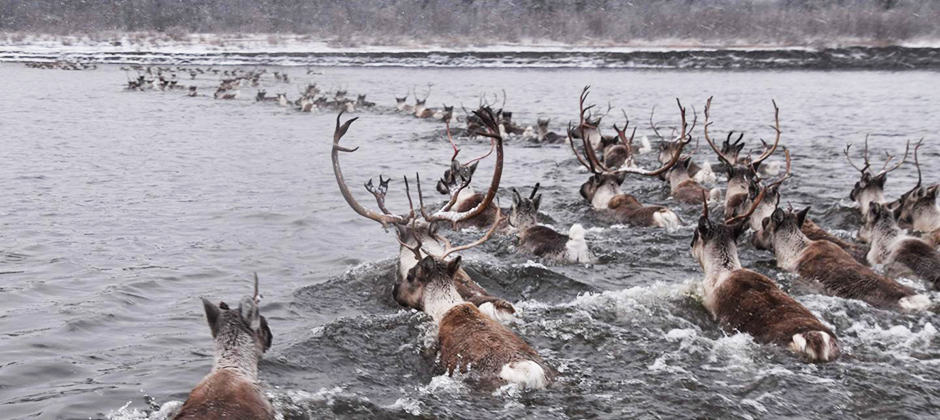Share this article
Tiny pests and warm weather can cause lag in caribou migration
When spring comes to the Arctic, caribou across Canada and Alaska synchronize the timing of their movement in a massive continent-wide migration to their calving grounds, researchers discovered. In some years, they all set off earlier. In other years, they all set off later.
When they reach the calving grounds has little to do with when they started their migration, though, the researchers found. Instead, the time it takes for them to cross the landscape appears to be associated with the weather from the previous summer and a warming climate’s impact on bloodsucking insects.
“In the very big picture, climate warming is a very big deal, and particularly a big deal in the Arctic,” said TWS member Eliezer Gurarie, an associate research scientist in the University of Maryland’s Department of Biology and lead author of the study published in Ecosphere. “A lot of these large-scale trends show increasing temperatures, shorter winters and changes in vegetation happening more dramatically in the north.”
Gurarie and his colleagues wanted to determine how caribou may be affected by the changing climate. They suspected earlier springs may cause earlier migrations.
Using remote sensing information from weather and climate data in Alaska and Canada, as well as satellite-tracked movement data for caribou (Rangifer tarandus), they analyzed over 20 years of data on 1,000 caribou from seven major herds ranging from the Bering Sea to the Hudson Bay.
After analyzing the movement data, they found that there were no strong trends towards earlier migrations. There was, however, an apparent continental-scaled synchronization in migration timing, even for herds that were thousands of miles apart. “That was very striking, and completely unexpected,” Gurarie said. The timing, they found, was related to large-scale climate indices that determine if winter produces snow that is wet, which researchers suspect makes it and harder for caribou to migrate through, or if it produces a harder snowpack better for migration.
While the start of migration showed large-scale synchrony, the timing of arrival on calving grounds varied greatly. “They’re so good at moving in these barren landscapes, which is not related to snow melting time at all,” he said. “If they want to get somewhere, they’ll get there early, and if they want to take their time, they’ll take their time. When they arrive is uncorrelated with when they leave and appears to be entirely driven by the need to calve at a certain time.”
Gurarie and his team found this variability depends on the weather from the previous summer. A cool and windy summer leads to an early arrival in the spring. After a warmer summer, the caribou arrived later. The researchers believe insect harassment and poor maternal health associated with warmer summers results in a lag in spring migration.
In the summer, calves are gaining weight, Gurarie said. If there are too many insects, rather than spending time foraging, caribou end up expending energy getting away from the pests. Cooler, windier summers, though, mean healthier body conditions. This, in turn, means a shorter gestation period, and the following year they need to calve earlier. As a result, they arrive earlier in their journey.
Unlike other migratory ungulates in North America like pronghorn (Antilocapra americana), elk (Cervus canadensis) or mule deer, caribou don’t “surf the green wave,” following green-up where forage quality is best, Gurarie said. “Surfing a green wave isn’t really an option, when much of the migration occurs while the ground is still snow-covered.” If anything, an Arctic green wave crashes over them after they’ve calved, but it is unfortunately often immediately followed by a wake of swarming, parasitic insects.
“Going forward, we want to look at how climate change might affect their populations,” he said. This is especially important since many caribou populations are crashing, yet historic fluctuations in their numbers make their dynamics hard to fathom.
“There’s a lot of mystery there,” Gurarie said, “and a lot more research to be done.”
The team found they could take massively-scaled movement and climate data to infer a story about individual caribou biology: their parasites, physical condition and reproduction.
“Most importantly,” Gurarie said, “the results point to some unexpected possible mechanisms and provide a sort of roadmap of processes to investigate further as we try to unravel the mystery — and possible fate — of Arctic caribou in a changing climate.”
Header Image: Insects can weaken caribou in the summer, making them take longer to reach calving grounds the following spring. ©Courtesy of NPS/Kyle Joly








